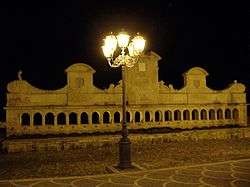Leonforte
| Leonforte Liunforti | |
|---|---|
| Comune | |
| Comune di Leonforte | |
|
Granfonte | |
 Leonforte Location of Leonforte in Italy | |
| Coordinates: 37°39′N 14°24′E / 37.650°N 14.400°ECoordinates: 37°39′N 14°24′E / 37.650°N 14.400°E | |
| Country | Italy |
| Region | Sicily |
| Province / Metropolitan city | Enna (EN) |
| Area | |
| • Total | 83 km2 (32 sq mi) |
| Elevation | 603 m (1,978 ft) |
| Population (December 31, 2004) | |
| • Total | 14,046 |
| • Density | 170/km2 (440/sq mi) |
| Demonym(s) | Leonfortesi |
| Time zone | CET (UTC+1) |
| • Summer (DST) | CEST (UTC+2) |
| Postal code | 94013 |
| Dialing code | 0935 |
| Patron saint | Madonna del Carmelo |
| Saint day | August 16 |
| Website | Official website |
Leonforte (Liunforti in sicilian) is an Italian comune with a population of 14,046[1] in the Province of Enna, Sicily. The town is situated 22 km from Enna, in the centre of the Erean Mountains at 600 metres a.s.l.
History
The ancient settlement of Tabas or Tavaca stood in the approximate location of Leonforte. During the reign of the Bizantine Empire, and later the reign of the Arabs, a castle was built with a farmhouse in its vicinity. Irrigation systems were introduced and many mills took advantage of the abundance of water. In 1610, after the reign of the Normans, Nicolò Placido Branciforti founded a city, naming it Leonforte in tribute to his family's coat of arms; a lion holding a banner with the motto in fortitudine bracchii tui.
Places of interest
Religious architecture in Leonforte includes: Chiesa Madre, Chiesa e Convento dei Padri Cappuccini (mausoleum that frames the sarcophagus of Princess Caterina Branciforte, who died in 1634. In addition, it houses a painting by Pietro Novelli, depicting the election of Matthias to the apostolate), Chiesa della Madonna del Carmelo, Chiesa di S.Stefano, Chiesa di S.Antonino, Chiesa di Santa Croce, Chiesa della Madonna della Carità, Chiesa della Mercede, Chiesa di S.Giuseppe (with frescoes), Chiesa di S.Francesco di Paola, Chiesa dell'Annunziata, Chiesa del SS.Salvatore, and Chiesa della Madonna della Catena. Civil architecture includes: Granfonte (Fontana dei 24 Cannoli), Palazzo Branciforti, Villa Comunale (Branciforti), Scuderia (Branciforti), Piazza 4 novembre, Villa Bonsignore, Giardino e Fontana delle ninfe, and Palazzo Gussio. Another historic site is the military castle, Castello di Tavi.
Society
On 31 December 2015, foreign residents in Leonforte numbered 171.[2] The most common nationalities are: Romanian (126), Chinese (11), Moroccan (7), German (5), Polish (5), Sri Lankan (3), Ukrainian (2), Russian (2), Dominican Republic (2), United States (2), Albanian (1), Bulgarian (1), United Kingdom (1), Thai (1), and Tunisian (1). Notable people linked to Leonforte include Silvio Proto and Salvo). From 18–19 March there is the Festa di San Giuseppe. On the 5th Sunday of Lent there is a procession. Soccer is the dominant sport played in Leonforte.[3][4][5][6]
Economy
The economy is largely based on agriculture. In the past century Leonforte has always had an agricultural economy with many labourers. This has made the town a stronghold for the political left. There are a few industries located within an industrial zone. Another important activity is construction work. Leonforte has one of the highest unemployment rates of the province, at 22%.[7] Leonforte is adjacent to the road Strada Statale 121 that connects Enna, Palermo, Nissoria, and Paternò. The train station is located 10 km from the centre of Leonforte.
References
- ↑ http://demo.istat.it/bil2015/index.html
- ↑ http://demo.istat.it/str2015/index.html
- ↑ "APD Leonfortese - Leonforte (Enna)". www.apdleonfortese.it. Retrieved 2015-05-31.
- ↑ "Sporting Club Leonforte". www.sportingclubleonforte.it. Retrieved 2015-05-31.
- ↑ Ipsale. "A.p.d. Città di Leonforte". www.calcioa5leonforte.it. Retrieved 2015-05-31.
- ↑ "Branciforti Calcio". www.branciforticalcio.it. Retrieved 2015-05-31.
- ↑
Bibliography
- Giovanni Mazzola, Notizie Storiche sulla vetusta Tavaca e sulla Moderna Leonforte, Tipografia Editrice del Lavoro, 1924
- Domenico Ligresti, Leonforte: un paese nuovo, in «Archivio Storico per la Sicilia Orientale» a. LXXIV, 1978, I pp. 89–118

